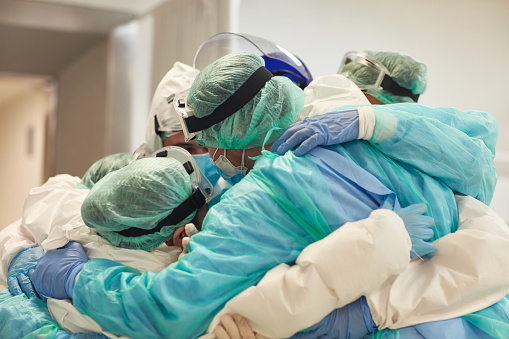
Partial view of hard-working male and female hospital team in full protective wear standing together in group embrace.
Pablo Balza
As COVID-19 cases continue to rise in Ontario, the City of Brampton and Peel region are topping the list for the highest concentration of cases.
In Brampton, the last time the levels were similar was back in June. Brampton has now become one of the most impacted cities in the GTA.
Brampton alone has had 4,818 cases confirmed in total as of Sept. 15. There were 29 new cases reported, with 315 cases hospitalized.
Overall, 58 percent of Peel Region cases occurred in Brampton from February to September.
Brampton has an infection rate of 711 per every 100,000 people. Mississauga, meanwhile, has 390 cases per 100,000 people.
Peel Region health experts are blaming multiple generation families for staying under the same household
Dr. Ripudaman Minhas, who works with the Inner City Health Program at St Michael’s Hospital in downtown Toronto, spoke on the situation regarding these multi generational households.
He said it’s all a matter of taking the right — and enough — precautions.
“COVID-19 cases are not rising due to having a large crowd of a multi-generational family under the same roof, they are rising because people don’t take the right health and safety measurements to protect their families and themselves,” Minhas said.
According to the Peel Region census bulletin of October of 2017 shows the following; 35.5 percent of Peel’s population were immigrants who came from India, 73.3 percent of Brampton’s population is made of visible minorities ethnically backgrounds and 51.5 percent of Peel’s populations is composed of immigrants.
Also, Peel Region released the COVID-19 cases by race category from April 13 to July 15. 45.1 percent South Asians, 22.6 percent White, 13.6 percent Black, 9.6 percent East/Southeast Asians, 4.6 percent Latinos, 3 percent Middle Easterns and 1.5 percent other races.
Evan Bodini, 17, who lives in Brampton, responded to people who question certain communities.
“I certainly believe that race does not alter the number of COVID-19 cases rising,” he said.
“At the end of the day anybody can contract the virus. There’s a lot of diversity in Brampton other than Indian and Pakistani and any nationality or multi-generational home can contract the virus,” Bodini told Humber News.
“Overall, it is hard to tell as of now, but the cases will keep rising since some schools and universities have started and having groups of people in a closed space can tend to lead to more new COVID-19 cases. Especially with the winter coming up which is usually known for flu season,” said Minhas.
In addition, Peel Region has currently the biggest amounts of active COVID-19 cases in Ontario per every 100,00 people in which is passing cities such as Toronto and Ottawa.
Ontario itself has an amount of 44,817 cases, while all of Canada has 138,010 total cases. However, 121,224 cases were recovered and unfortunately, 9,179 cases were reported as deaths.
Meanwhile, Brampton has only one testing centre that can hold an estimated 600,000 people.
A second location is set to open on Tuesday.
